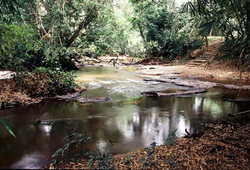Donkor Nsuo: Ghana’s Historic Slave River of Remembrance
Donkor Nsuo: Ghana’s Slave River of Memory and the Last Bath Before the Door of No Return
Tucked away in the quiet town of Assin Manso, in Ghana’s Central Region, lies one of the most emotionally charged and historically significant places in the country: Donkor Nsuo, or “The Slave River.” This once-unassuming river served as the final resting and cleansing point for enslaved Africans before they were marched to the coast and sold into lives of brutal servitude across the Atlantic. Today, it stands as a living memorial—a place of reflection, remembrance, and reconciliation.

Slave Hunters handing over their victims to European Slave Traders!
Located less than 100 kilometers inland from the slave castles of Cape Coast and Elmina, Donkor Nsuo was strategically positioned on the slave route that connected the African interior to the European-controlled trading forts. Slaves captured in the northern regions of what is now Ghana—including areas like Northern Ghana, Burkina Faso, and the Kingdom of Dagbon—were forcibly marched for weeks, often in chains, with minimal food or water. Many perished along the way, while those who survived eventually arrived at Assin Manso.
Here, the captives were given what became known as their “last bath” in African waters. This wasn’t a ritual of comfort, but a chilling symbolic cleansing, intended to ready them for sale at the coastal castles. At the river, the captives were washed, sometimes shackled to a large tree stump still visible near the riverbank today. This stump is said to “hold the secrets” of the many men, women, and children who passed through—witnesses to their pain, trauma, and the final moments of freedom on African soil.
From the Gold Coast and Ivory Coast to the Slave Coast
From Assin Manso, they were taken to Elmina Castle and Cape Coast Castle, both serving as major depots in the transatlantic slave trade. Elmina Castle, constructed by the Portuguese in the late 15th century and later taken over by the Dutch and British, was one of the earliest European structures in sub-Saharan Africa. It became a center of commerce—not only for gold and ivory—but eventually for humans. Here, enslaved people were kept in suffocating dungeons beneath the ground, often for weeks, until a ship arrived.
Once a vessel was ready, the captives were marched to the infamous “Door of No Return.” This heavy wooden door, set in thick stone walls, opened directly onto the sea or onto boats that ferried the enslaved to awaiting ships. It is said that no one walks through the door without feeling a surge of sorrow, the palpable weight of untold suffering that clings to its stones. The name itself speaks volumes—no return, no reunion, no hope of home.
for local artisans and traders.

